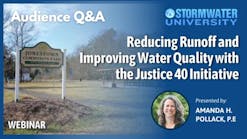Deeper Understanding of Heavy Metals & Deicing Salts Leads To Improved Water Quality
by Ann Ryan
Decades of research has established the fact that pollutants in untreated storm water can significantly damage water quality in groundwater, waterways and water bodies. In fact, the U.S. EPA identifies polluted runoff “as one of the greatest threats to clean water” in the U.S. Historically, much of the research into this environmental problem has focused on specific pollutants, such as salts or heavy metals. Numerous studies around the world show that high concentrations of salts and heavy metals from runoff can lead to severe, long-term damage, even death, in fish and aquatic plants, as well as making waterways and water bodies uninhabitable. In addition, polluted runoff that enters aquifers can endanger sources of drinking water.
The confluence of two trends in the U.S. — rising urban development (resulting in more land turned into impervious cover) and the growing use of deicing salts — has caused environmental scientists and storm water system designers to look even more seriously at the environmental damage caused by heavy metals. As of 2020, nearly 83% of the U.S. population lived in urban areas. That same year, approximately 24 million tons of salt were applied to U.S. roads. It is estimated that at least that much again is applied to private roads and property.
Having large areas of impervious cover impedes the natural process of filtration that occurs when rainwater sinks into the ground. In urban areas, when rain falls on impervious roads, parking areas and roofs, as much as 55% of the water is unable to soak into the ground, according to numerous sources, including the EPA. The resulting runoff, containing pollutants such as heavy metals, runs along these impervious surfaces into ditches, culverts and tributaries and eventually into bodies of water or into municipal storm water and wastewater systems. This points to the added problem that high concentrations of heavy metals in runoff not only harms waterways and water bodies, but also strains municipal wastewater systems.
While heavy metals can be valuable nutrients, they become toxic at high concentrations. Runoff from parking and road surfaces generally contains higher levels of heavy metals than other types of runoffs. Metals in roof and traffic runoff contribute up to 80% of the heavy metals in the total mass flow in combined sewer systems. Cadmium, chromium, copper, nickel, phosphorous and zinc are the primary heavy metals found in this type of runoff. Zinc and copper, the most toxic of these, are of particular concern in high traffic areas. Beyond natural sources of these metals (such as windblown dust, forest fires, sea spray and volcanic eruptions, major sources are brake linings, tires, meal plating, engines, deicing salts, electronics, lubricating oil, exhaust, fuel additives, asphalt, batteries, petroleum products and traffic devices. Additionally, depending on the location, copper and zinc come from manufacturing and processing facilities (electrical, metal and leather), mining, and agricultural pesticides and fungicides.
Recognized just recently as an urgent concern, the problem with heavy metals in high-traffic areas has been recognized for decades. As early as 1998, Carsten Dierkes and W.F. Geiger wrote: “Runoff from highways contains significant loads of heavy metals and hydrocarbons.…As pollutant loads are closely connected to traffic density, streets with highest traffic have greatest impact on roadside soils and groundwater.” (“Decontaminating effects of soil-passages for the infiltration of highway runoff”)
Compounding the problem of heavy metals in runoff is 80-plus years of ever-increasing use of road salts. In the decades that salt has been used to manage ice and snow on U.S. roads, the quantity has increased exponentially — from 164,000 tons in 1940 to approximately 24 million tons in 2020, according to U.S. Geological Statistics. Estimates put road salt use on private and industrial property at approximately the same amount. A 2021 study published in the Ecological Society of America puts the percentage of the U.S. population living in snow and ice regions at 70%. Authors William D. Hintz, Laura Fay and Rick A. Relyea present a multipronged approach to reducing the harm from deicing salts on freshwater ecosystems, including calibrating salting equipment, storing salt securely, timing the application of salts and using live-edge plows. They also point to the particular problem related to the remobilization of heavy metals.
While regions, cities and municipalities work to incorporate these best management practices (BMPs), the specific problem related to heavy metals and deicing salts remains a separate issue. The problem of heavy metal pollution as it relates to deicing salts is that heavy metals trapped on impervious surfaces and in storm water systems during summer months are remobilized when deicing salts are applied to roadways and parking areas during winter months. Heavy metals (from tires and brake pads, for instance) accumulate during periods of light rainfall and are then released in high concentrations during periods of heavy rain and snow. The complication with deicing salts is that they accelerate the movement of heavy metals in runoff.
This particularly impacts regions with heavy snowfall. In the U.S., essentially two-thirds of the states have significant snowfalls and have heavy road salt use (primarily sodium chloride, and to a lesser degree calcium chloride and magnesium chloride). In fact, 31 states and the District of Columbia comprise the Salt Belt, and apply heavy applications of deicing salts. Examples of heavy snowfall cities range from Buffalo and Rochester, New York (with 95 to 100 inches annually), to cities like Cleveland, Denver, Minneapolis and Salt Lake City (all receiving more than 50 inches). Numerous cities in Connecticut, Illinois, Indiana, Massachusetts, Michigan, New York, Ohio, Pennsylvania, Rhode Island and Wisconsin receive in excess of 35 inches a year. However, even low snowfall states are affected. As they experience more sleet and ice storms, they, too, turn to road salts to manage roads, pathways and parking areas.
Individual states have taken the lead in addressing the environmental harm caused by heavy metals. For instance, both California and Washington enacted legislation requiring brake pads sold or installed in their states to have reduced levels of heavy metals, including copper. The use of non-zinc coatings for galvanized roofs is an example of how businesses and industries are working to reduce zinc that can enter runoff. Efforts to reduce harm caused by deicing salts include using different compositions of salts and experimenting with non-chloride ingredients to reduce the amount of salt used. The Minnesota Department of Transportation pioneered the use of beet juice as an additive, and it is currently being applied in numerous states, including Colorado, Kansas, Missouri, Nebraska, New Jersey, North Dakota, Ohio, Wisconsin and Wyoming. Around the country, regions and cities are working to reduce their use of road salts. For instance, the city of Edina, Minnesota, reports a 30% decrease in the last five years, primarily accomplished by using updated equipment and technology, and training their drivers in “smart salting.”
While positive, these efforts need to be met with storm water filtration solutions that are proven effective at removing heavy metals from entering runoff. Many researchers and companies are expanding their focus on heavy metal pollution in runoff to factor in the impact deicing salts have on the behavior of heavy metals. Such research will help agencies and regulators develop testing protocols for measuring the efficacy of heavy metal removal in storm water systems. Few agencies currently factor in the impact of deicing salts on heavy metals in runoff, and those that do rely on either laboratory or field tests, but not both. Both tests have an important value: the control of factors possible in lab tests and the real-life rain-event activity of field tests. Worldwide, the most stringent testing requires both protocols.
As agencies and municipalities throughout North America plan for both new and improved infrastructure projects, it is forward-thinking to incorporate a new storm water best management practice that focuses on the specific harm caused when heavy metals are remobilized by deicing salts. Matthew Schuler and Relyea state the need to better understand how heavy metals mobilized by road salts alter ecosystems and pose a risk through contaminated water used for drinking and agriculture (March 2018, Bioscience).
In the meantime, an effective practice to mitigate heavy metal damage is site specific treatment. Studies going back 15 years argue that “Source control by the decentralised treatment of polluted runoff from motorways and highways” is a sustainable alternative. “Areas with high loads of harmful substances can be equipped with filters,” wrote Dierkes, A. Schumann and G. Hyett in “Performance of an innovative treatment device for runoff from roads with high traffic densities,” presented at the International Conference on Urban Drainage in Edinburgh, Scotland in 2008.
Among those taking the lead in project-based solutions are companies that provide storm water systems with filter media proven to trap heavy metals when deicing salts are added to the mix. An example of filter media with proven efficacy is one consisting of active coal, calcium carbonate and zeolite. The combined efforts of agencies and businesses will constitute a major advancement in addressing the great threat that polluted storm water poses to clean water sources.
About the author:
Ann K. Ryan has written for international publications for more than 30 years. She is also a communications consultant for Shawcor. Ryan can be reached at [email protected].






